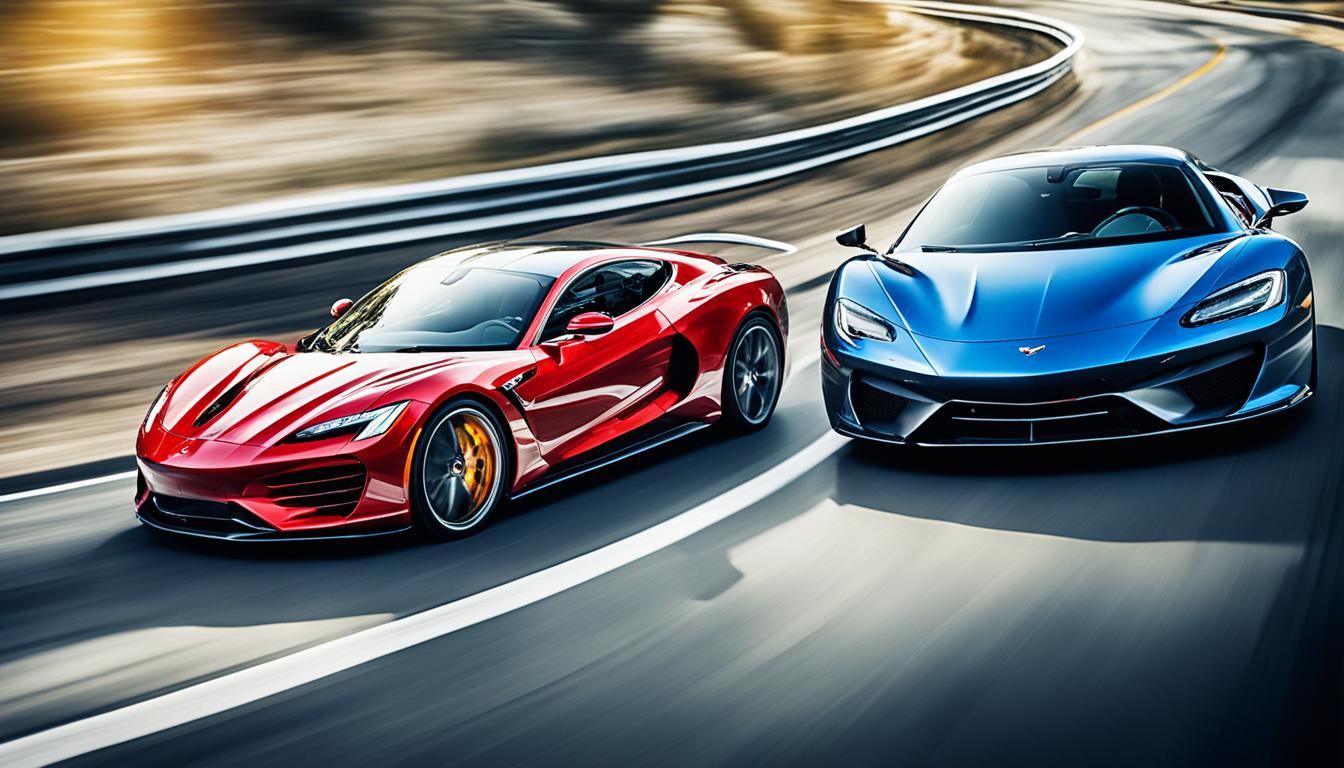High-performance sports cars are the top of engineering, blending luxury with amazing speed and precise handling. They are made for those who love thrilling drives. These cars are not just beautiful but also built to improve speed and stability. Famous brands like Ferrari, Porsche, and Lamborghini lead this field, offering luxury cars for car lovers worldwide.
These cars have advanced engineering with strong engines for fast acceleration. For example, the Subaru WRX Project Midnight has a 2.0-liter engine that makes 670 horsepower and 680 pound-feet of torque. This shows how modern sports cars can perform. It also shows how aerodynamics help with stability, with features like wide wheel arches and a big front spoiler.
Looking into high-performance sports cars, we see how they’ve evolved and what makes them special. This look into automotive engineering shows the design and tech advances. It also shows what makes these cars stand out in the market.
Key Takeaways
- High-performance sports cars combine speed, luxury, and advanced engineering.
- Brands like Ferrari and Porsche lead the luxury sports car market.
- Powerful engines significantly enhance sports car acceleration and performance.
- Aerodynamic enhancements contribute to improved stability and fuel efficiency.
- These cars often feature state-of-the-art braking systems for optimal safety.
The Evolution of High-performance Sports Cars
Performance cars have changed a lot since they first came out. These changes have made a big impact on the car world. They show how engineering has gotten better and how what people want has changed over time.
History and Milestones in Sports Car Engineering
High-performance sports cars started in the early 1900s with brands like Alfa Romeo and Bugatti. These early cars set the stage for a growing market. A big step was the MG T-series in the 1920s, one of the first sports cars made for many people.
Then, the 1950s and 1960s brought motorsport to the forefront. This led to cars getting better and better. Manufacturers worked hard to improve their cars.
Key Innovations that Shaped Modern Performance
Over time, some big changes made sports cars much better. Things like disc brakes made stopping safer and faster. Using lighter materials and better aerodynamics became key for modern cars.
The Mercedes-AMG One is a perfect example of these changes. It has a powerful 1.6-liter engine that makes over 1,000 horsepower. It goes from 0 to 60 MPH in just 2.9 seconds, showing how far sports cars have come.
Essential Features of High-performance Sports Cars
High-performance sports cars have amazing features that make them stand out. They come with powerful engines, smart aerodynamics, and top-notch brakes. These features work together for amazing performance.
Sports Car Engines: Power and Efficiency
Modern sports car engines are all about power and efficiency. They use turbocharging and direct fuel injection. For instance, the Mercedes-AMG One has a turbocharged 1.6-liter V-6 engine that makes over 1,000 horsepower.
This engine helps the car go from 0-60 mph in just 2.9 seconds. It’s a thrill for car lovers.
Aerodynamics in Sports Car Design
Aerodynamics is key in making high-performance cars fast and stable. Cars have sleek designs and special parts like front splitters and rear spoilers. These parts help cut down on drag and keep the car stable at high speeds.
The Subaru WRX Project Midnight shows how this works with its winglets and big front spoiler. These features help the car go faster and handle better.
Advanced Braking Systems for Enhanced Safety
Safety is very important in sports cars, and good brakes are crucial. Cars have carbon-ceramic discs and ABS for top braking power. These brakes help drivers stay in control, even when driving fast.
The Alfa Romeo Stelvio Quadrifoglio is a great example. It has amazing handling and strong brakes. This lets drivers have fun without risking their safety.
Performance Metrics: Speed, Acceleration, and Handling
Understanding performance metrics is key to judging high-performance sports cars. These metrics include sports car speed, acceleration, and handling. They show how well a car does on the road and track. Enthusiasts and buyers look at these when choosing a car.
Measuring Sports Car Speed and Acceleration
Sports car speed is measured by top speed and quarter-mile times. For example, the Bugatti Chiron hits over 300 mph. Acceleration is how fast a car goes from 0 to 60 mph. Many sports cars do this in under three seconds, showing their speed.
Other things like weight, tire grip, and engine power also affect acceleration.
The Importance of Sports Car Handling
Handling is just as important as speed and acceleration. It’s about how a car turns and stays stable when cornering. The Porsche 911 is great at this, thanks to its balanced weight and suspension. This makes the car fun to drive fast and safe.
High-performance Sports Cars
The world of high-performance sports cars is full of variety. It has models for different driving styles and tastes. For example, the Subaru WRX Project Midnight has a 2.0-liter flat-four engine. This engine produces 670 horsepower and 680 pound-feet of torque. It also has aerodynamic parts like front winglets and a big front spoiler for better stability and speed.
Top Models and Their Unique Features
The 2024 Lamborghini Revuelto Opera Unica is a standout. It has a powerful engine and three electric motors for a total of 1015 CV. It features advanced technology like a double-clutch gearbox and is beautifully hand-painted. These features show how today’s sports cars are pushing the limits in engineering and design.
Comparing Sports Car Performance Across Brands
When comparing top brands, we see big differences in speed, acceleration, and handling. The Porsche 911 GT1 can go 191 MPH and gets to 60 MPH in 3.9 seconds. The Ferrari F50 is even faster, reaching 202 MPH and hitting 60 MPH in 3.8 seconds. This shows how each brand uses unique technology to make their cars stand out.
